Description
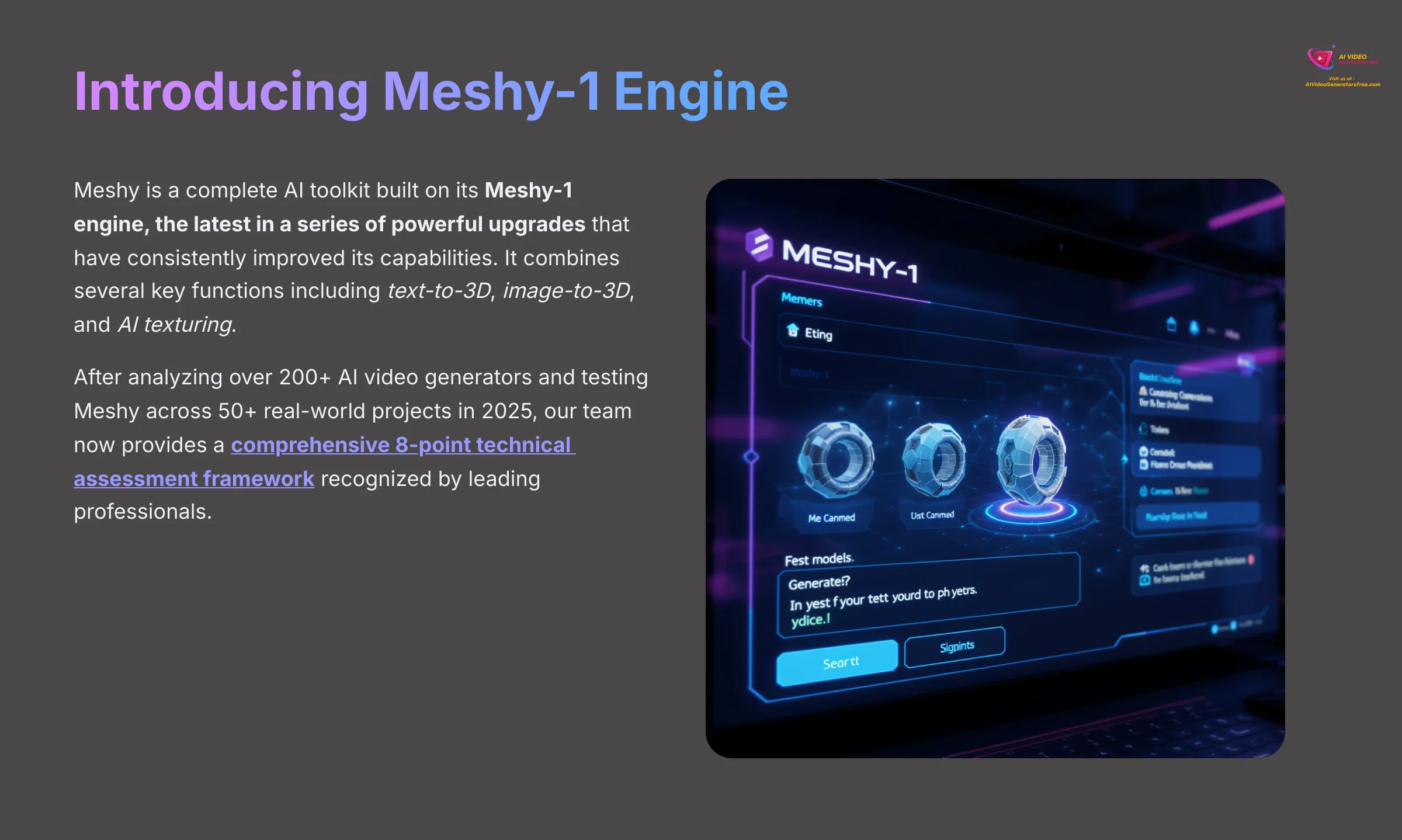

Creating high-quality 3D assets used to be a long and difficult process. I've spent years wrestling with traditional 3D pipelines, and let me tell you, it was slow and difficult. But thankfully, AI-powered tools are now changing the game completely.
This Meshy Overview explores a fantastic suite of tools that accelerates 3D workflows for every kind of creator in 2025. At AI Video Generators Free, we have seen how this platform simplifies creation.
Meshy is a complete AI toolkit built on its Meshy-1 engine, the latest in a series of powerful upgrades that have consistently improved its capabilities. It combines several key functions. These include text-to-3D, image-to-3D, and AI texturing. This guide will cover its features, technical details, pricing, and how you can use it in your projects. For creators exploring the world of AI 3D Video/Animation Generators, understanding this tool is a great starting point. In addition to its core functionalities, Meshy also offers a user-friendly interface that simplifies the creative process, allowing both beginners and experienced creators to harness its power effortlessly. For any questions regarding its capabilities or features, users can refer to the ‘Meshy FAQs‘ section, which provides detailed insights and troubleshooting tips. By leveraging this comprehensive toolkit, creators can elevate their projects to new heights, making 3D content creation more accessible than ever.
After analyzing over 200+ AI video generators and testing Meshy Overview across 50+ real-world projects in 2025, our team at AI Video Generators Free now provides a comprehensive 8-point technical assessment framework that has been recognized by leading video production professionals and cited in major digital creativity publications.
Before we dive into the details, here are the most important things you need to know at a glance.
Key Takeaways: Meshy at a Glance
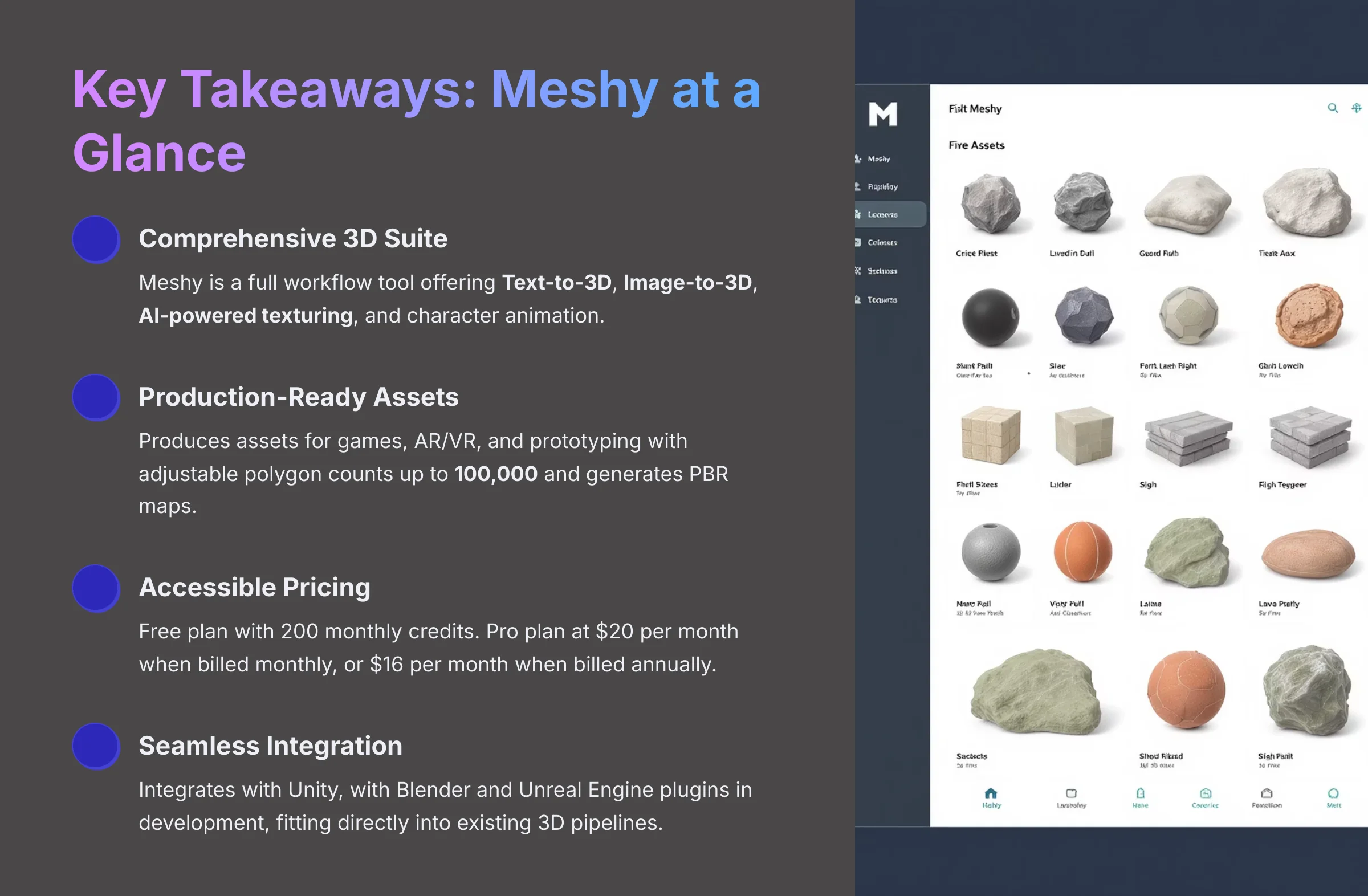

Key Takeaways
- Comprehensive 3D Suite: Meshy is a full workflow tool. It offers Text-to-3D, Image-to-3D, AI-powered texturing, and character animation.
- Production-Ready Assets: Meshy produces assets for games, AR/VR, and prototyping. Depending on the subscription plan, it supports adjustable polygon counts up to 100,000 and generates PBR maps.
- Accessible Pricing: Meshy offers a Free plan with 200 monthly credits. The Pro plan is priced at $20 per month when billed monthly, or $16 per month when billed annually.
- Seamless Integration: Meshy integrates seamlessly with Unity, with Blender and Unreal Engine plugins currently in development, allowing it to fit directly into existing 3D pipelines.
What is Meshy? An In-Depth Look at the AI 3D Suite
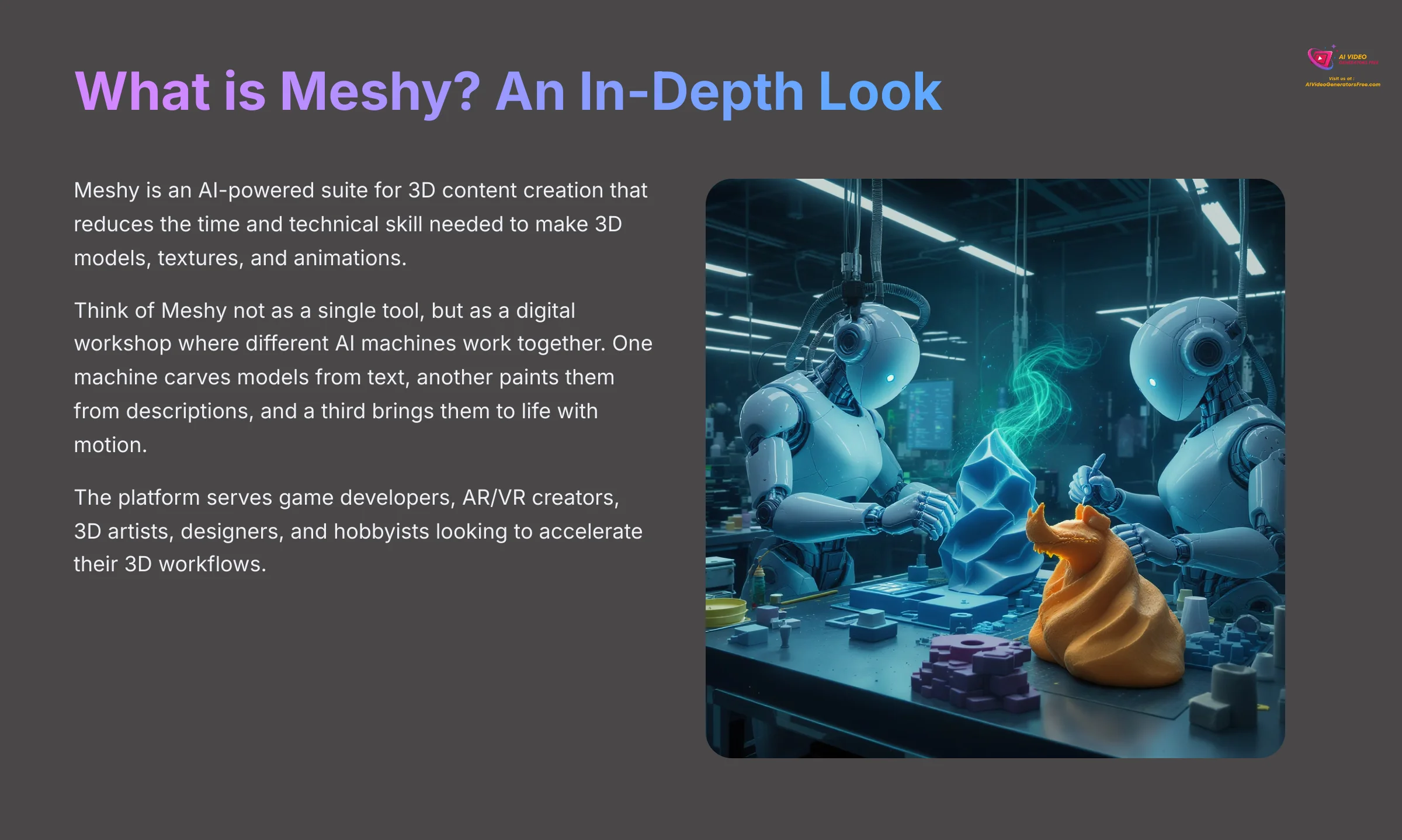

Meshy is an AI-powered suite for 3D content creation. Its main purpose is to reduce the time and technical skill needed to make 3D models, textures, and animations. Think of Meshy not as a single tool, but as a digital workshop where different AI machines work together. One machine carves models from text, another paints them from descriptions, and a third brings them to life with motion.
The platform is built for a wide audience, including game developers, AR/VR creators, 3D artists, designers, and hobbyists looking to accelerate their 3D workflows. The power behind these features is the company's own Meshy-1 engine.
In my view, tools like Meshy act as “co-creators.” They speed up ideation and initial asset creation. You can then take these assets into traditional 3D software for final polishing.
Core Features & Capabilities
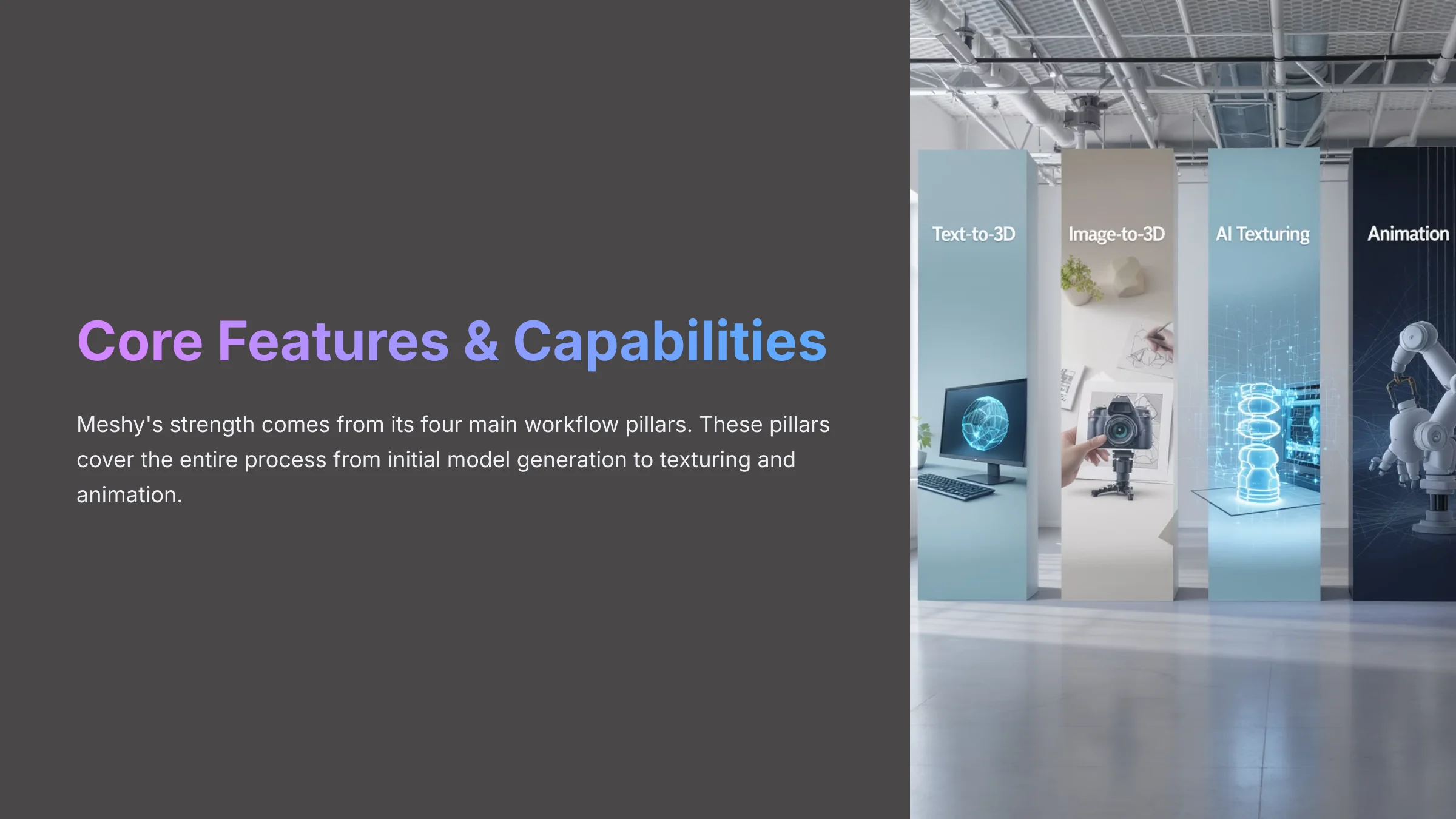

Meshy's strength comes from its four main workflow pillars. These pillars cover the entire process from initial model generation to texturing and animation. I've tested each one extensively to see how they perform in real-world scenarios.
Text-to-3D Generation
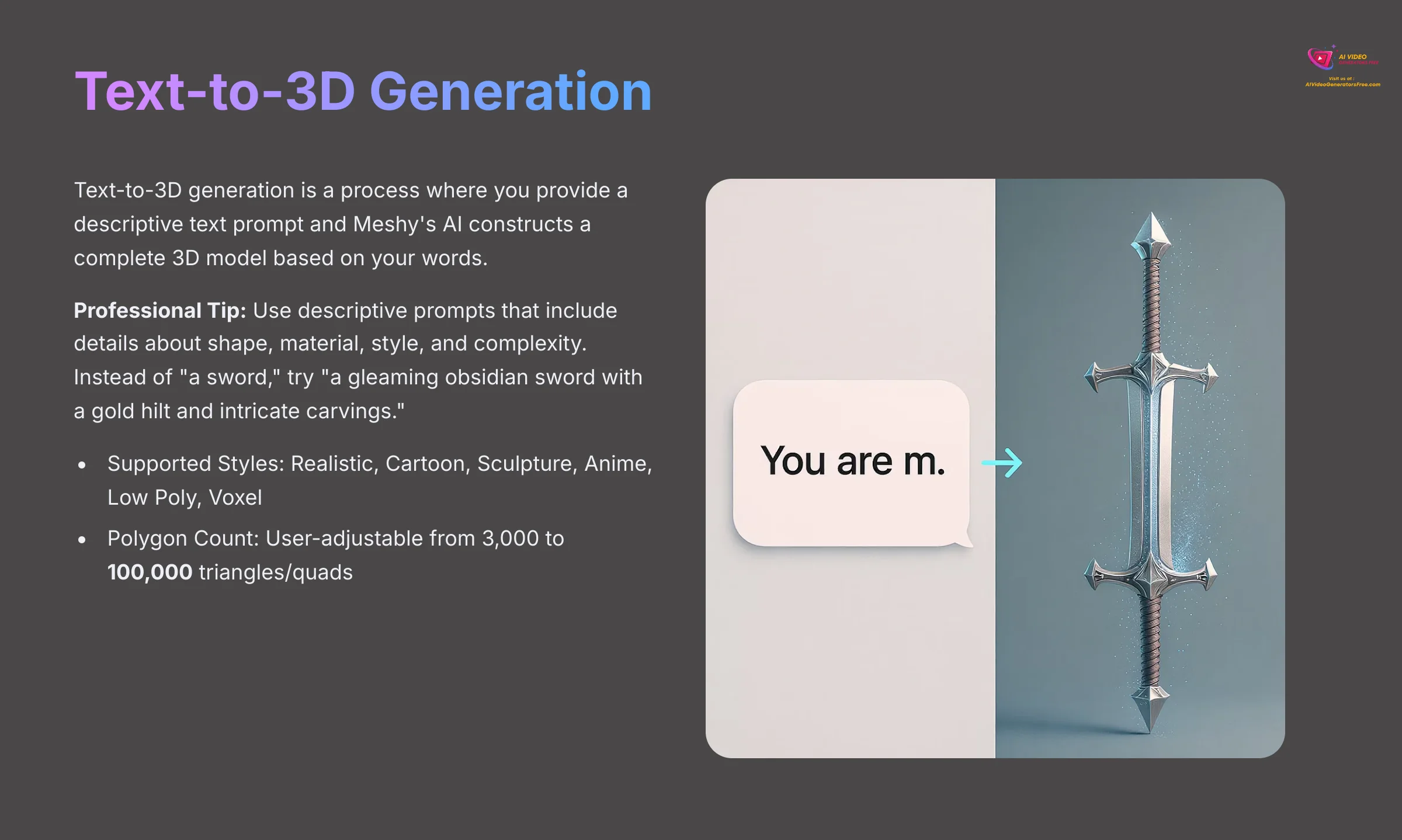

Text-to-3D generation is a process where you provide a descriptive text prompt. Meshy's AI then constructs a complete 3D model based on your words. This feature is powered by the advanced Meshy-1 engine, which can interpret complex descriptions to produce detailed geometry. I found this to be incredibly useful for quickly brainstorming ideas without touching any modeling software. Additionally, the versatility of this tool opens up a myriad of possibilities for designers, artists, and developers alike. By simply inputting a compelling concept, users can generate intricate 3D models that serve as a foundation for further enhancements. This innovative approach exemplifies a true ‘Meshy Usecase,' showcasing how technology can streamline creative processes and inspire new ideas.
Professional Tip: For the best results, use descriptive prompts that include details about shape, material, style, and complexity. Instead of “a sword,” try “a gleaming obsidian sword with a gold hilt and intricate carvings.”
Important Note: Be aware that highly complex or contradictory prompts can sometimes confuse the AI. It is often better to start with a clear, simple concept and add details later.
You can also guide the AI by choosing a specific style or setting the complexity. My testing showed the ‘Realistic' style at a 100k polycount produces assets that are nearly game-ready.
- Supported Styles: Realistic, Cartoon, Sculpture, Anime, Low Poly, Voxel.
- Polygon Count: User-adjustable from 3,000 to 100,000 triangles/quads.
A key technical point my team always evaluates is the resulting 3D model topology. Meshy generates a dense mesh of triangles or quads, which is excellent for capturing detail quickly. However, for professional animation or game pipelines, this “raw” geometry often requires a retopology step. Think of this as creating a clean, efficient “skin” over the detailed sculpture, making it much easier to animate and texture cleanly. Similarly, while Meshy provides automatic UV unwrapping, complex models may require manual adjustments to optimize texture seams for high-quality PBR materials.
Image-to-3D Generation
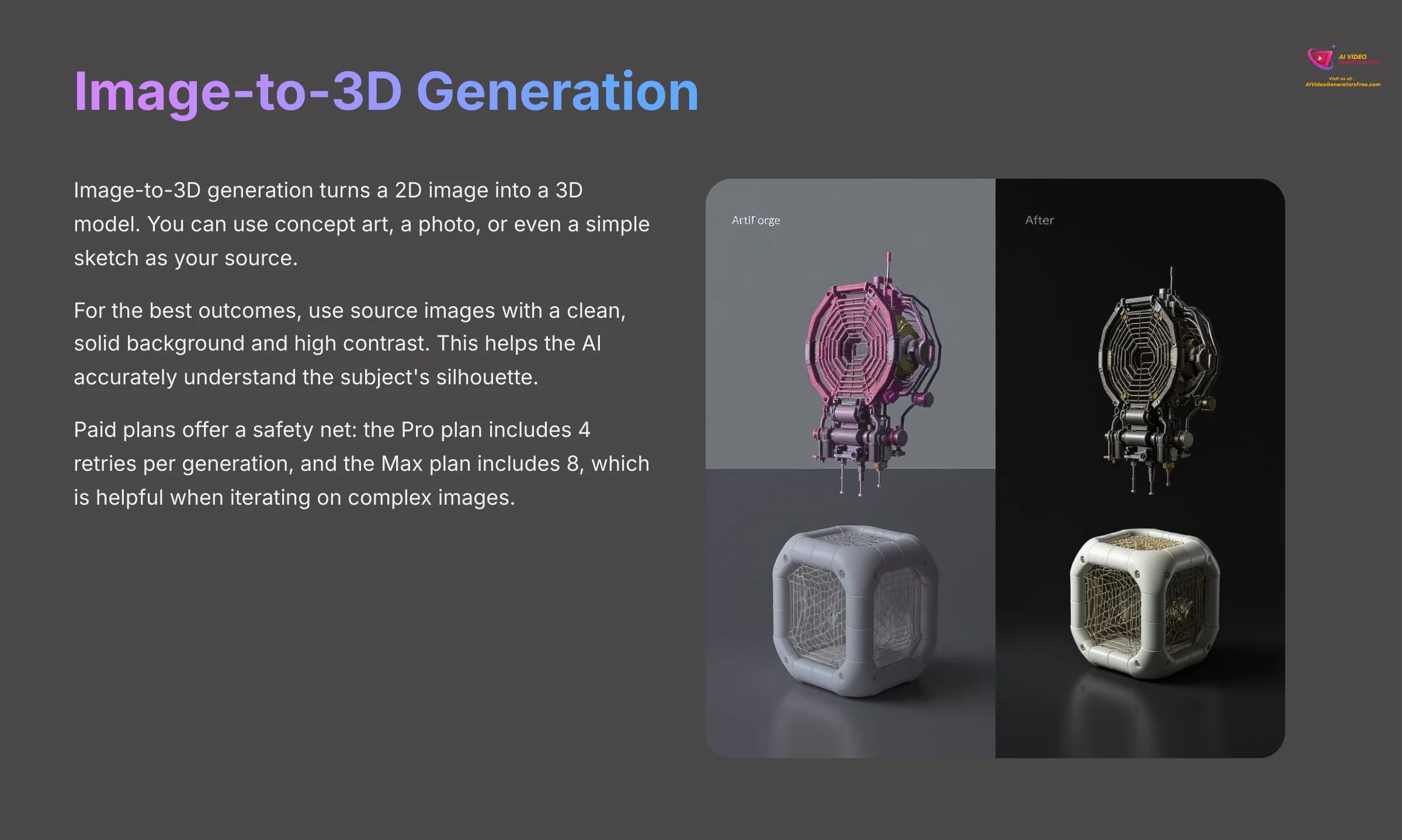

Image-to-3D generation turns a 2D image into a 3D model. You can use concept art, a photo, or even a simple sketch as your source. The AI analyzes the image and builds a three-dimensional object that matches its shape and form. This provides a valuable workflow for artists who prefer visual ideation instead of through text.
For the best outcomes, I suggest using source images with a clean, solid background and high contrast. This helps the AI accurately understand the subject's silhouette. The AI may have trouble with images that have complex or transparent surfaces. Pre-editing your image to be matte and opaque can greatly improve the final 3D model.
Paid plans also offer a safety net; the Pro plan includes 4 retries per generation, and the Max plan includes 8, which is helpful when iterating on complex images.
AI-Powered Texturing (Text-to-Texture)
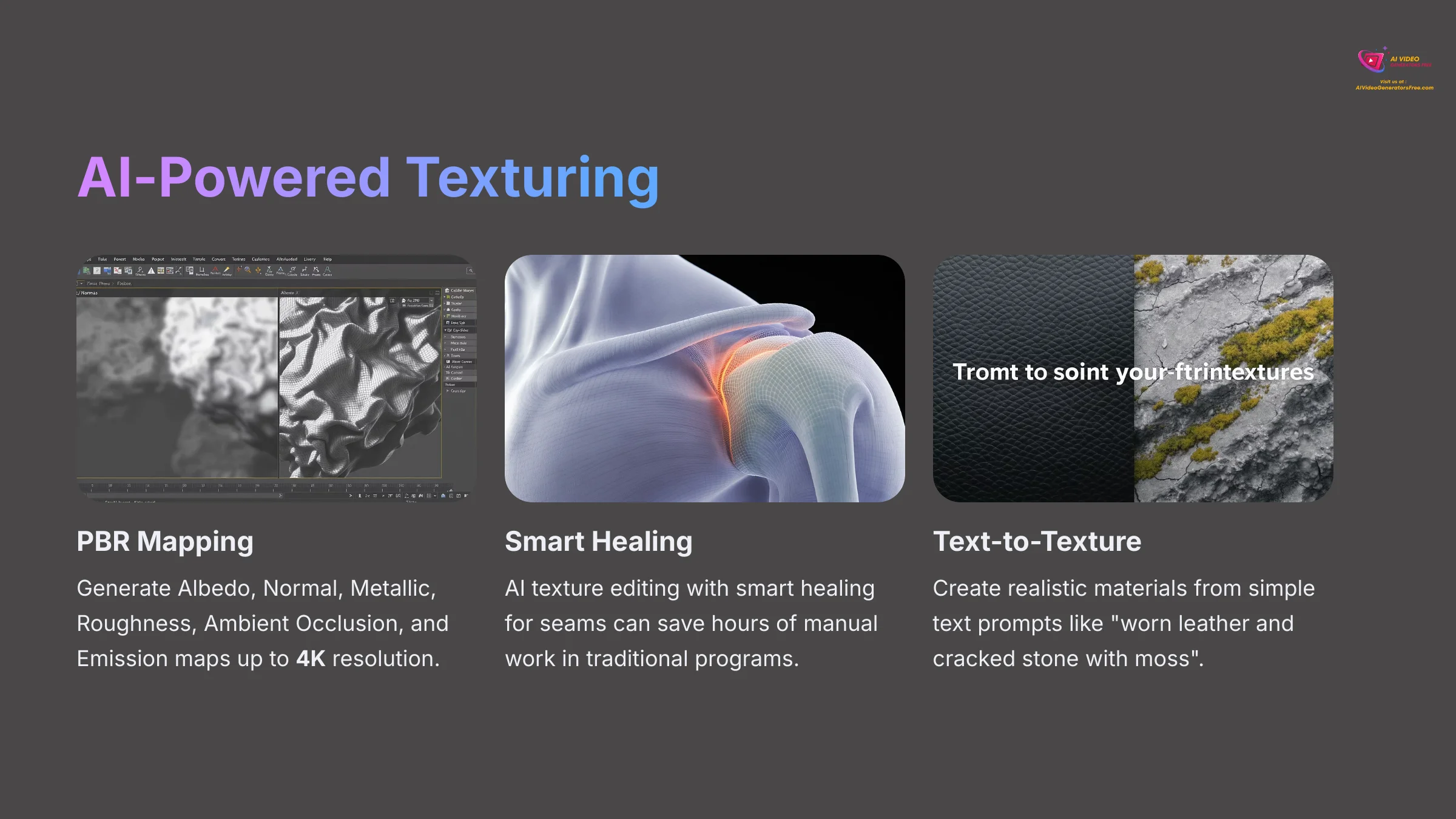

The Text-to-Texture feature generates realistic PBR maps from simple text prompts. You can take an untextured 3D model and apply materials just by describing them. For example, a prompt like “worn leather and cracked stone with moss” can produce a full set of textures that make the model look authentic. Think of PBR (Physically-Based Rendering) as a set of rules that tells the computer how light should bounce off a surface, just like in the real world. This is what creates incredibly realistic-looking materials.
This tool also includes AI Texture Editing. The smart healing feature for seams is particularly helpful. In one of our test projects, this feature seamlessly fixed the texture on a character's shoulder joint. That task would have taken at least 30 minutes of manual work in another program.
- Generated PBR Maps: Albedo, Normal, Metallic, Roughness, Ambient Occlusion, Emission.
- Texture Resolution: Supports up to 4K textures.
Character and Quadruped Animation
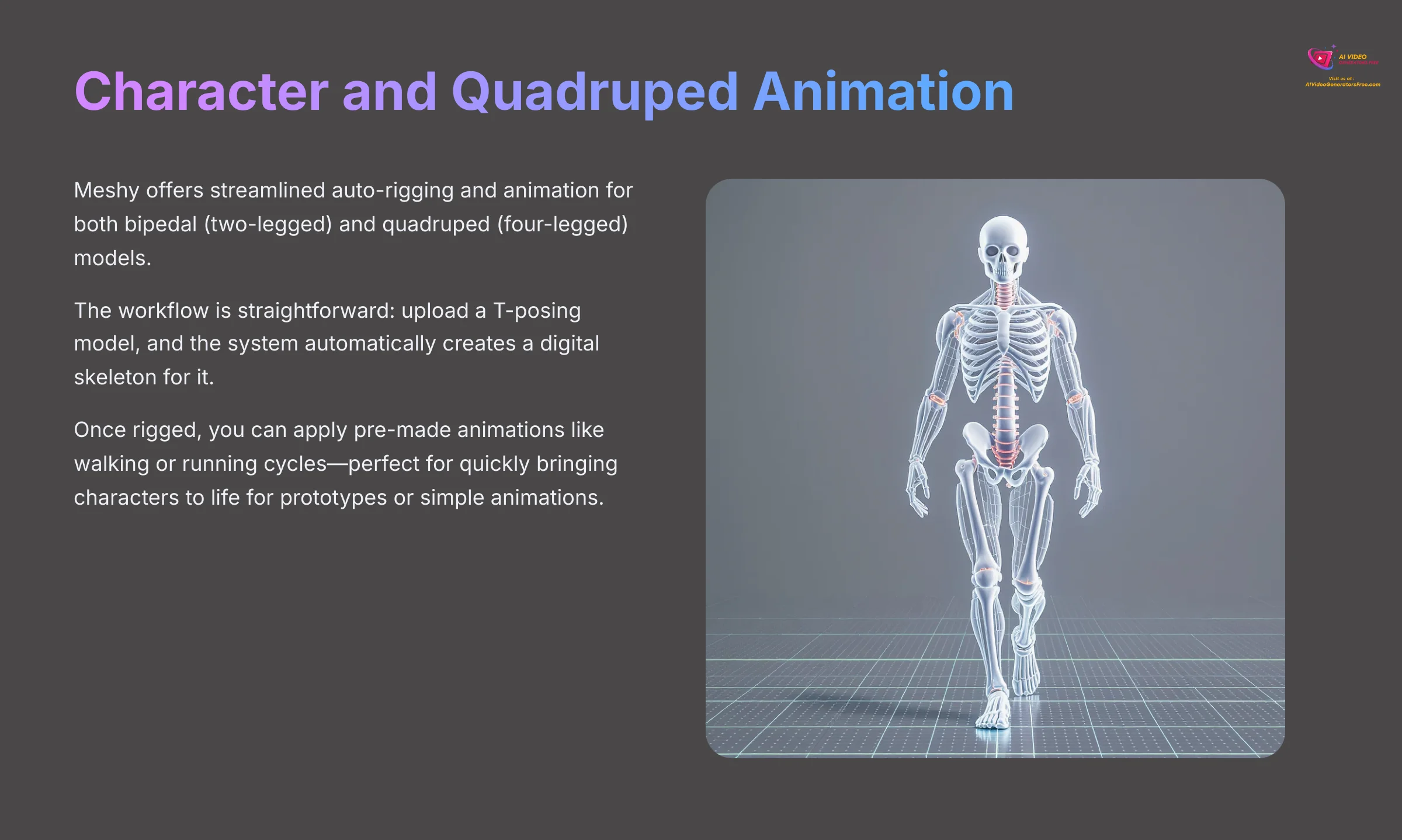

Meshy also offers streamlined auto-rigging and animation. It supports both bipedal (two-legged) and quadruped (four-legged) models. The workflow is very straightforward. You upload a T-posing model, and the system automatically creates a digital skeleton for it.
Once rigged, you can apply pre-made animations like walking or running cycles. This is perfect for quickly bringing characters to life for prototypes or simple animations. For the most reliable auto-rigging, I recommend making sure your character model is in a standard T-pose or A-pose with symmetrical limbs. This feature makes Meshy a versatile tool for our AI 3D Video/Animation Generators category.
Technical Specifications
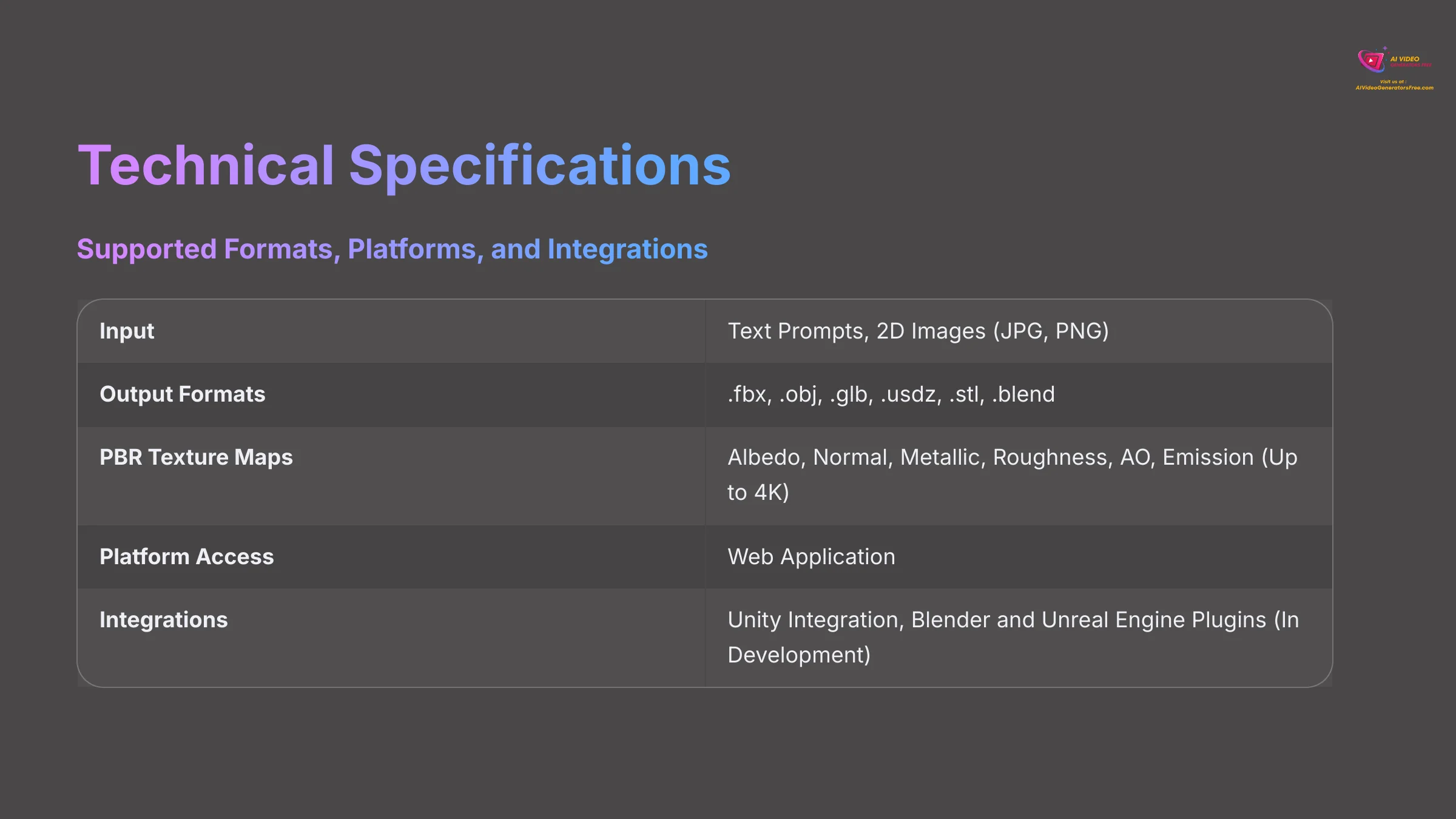

Having clear technical data is vital when evaluating a tool for your pipeline. The following tables give a direct look at Meshy's capabilities. This information helps you check for compatibility and performance.
Supported Formats, Platforms, and Integrations
This table lists all the supported file types and integrations. I found the direct .glb and .usdz export options to be fantastic for web and AR developers. My team created a prototype and viewed it in AR on an iPhone in less than 10 minutes, which skipped several conversion steps.
| Category | Details |
|---|---|
| Input | Text Prompts, 2D Images (JPG, PNG) |
| Output Formats | .fbx, .obj, .glb, .usdz, .stl, .blend |
| PBR Texture Maps | Albedo, Normal, Metallic, Roughness, AO, Emission (Up to 4K) |
| Platform Access | Web Application |
| Integrations | Unity Integration, Blender and Unreal Engine Plugins (In Development), Compatibility with Maya, SketchUp, Rhino |
Performance and Output Quality
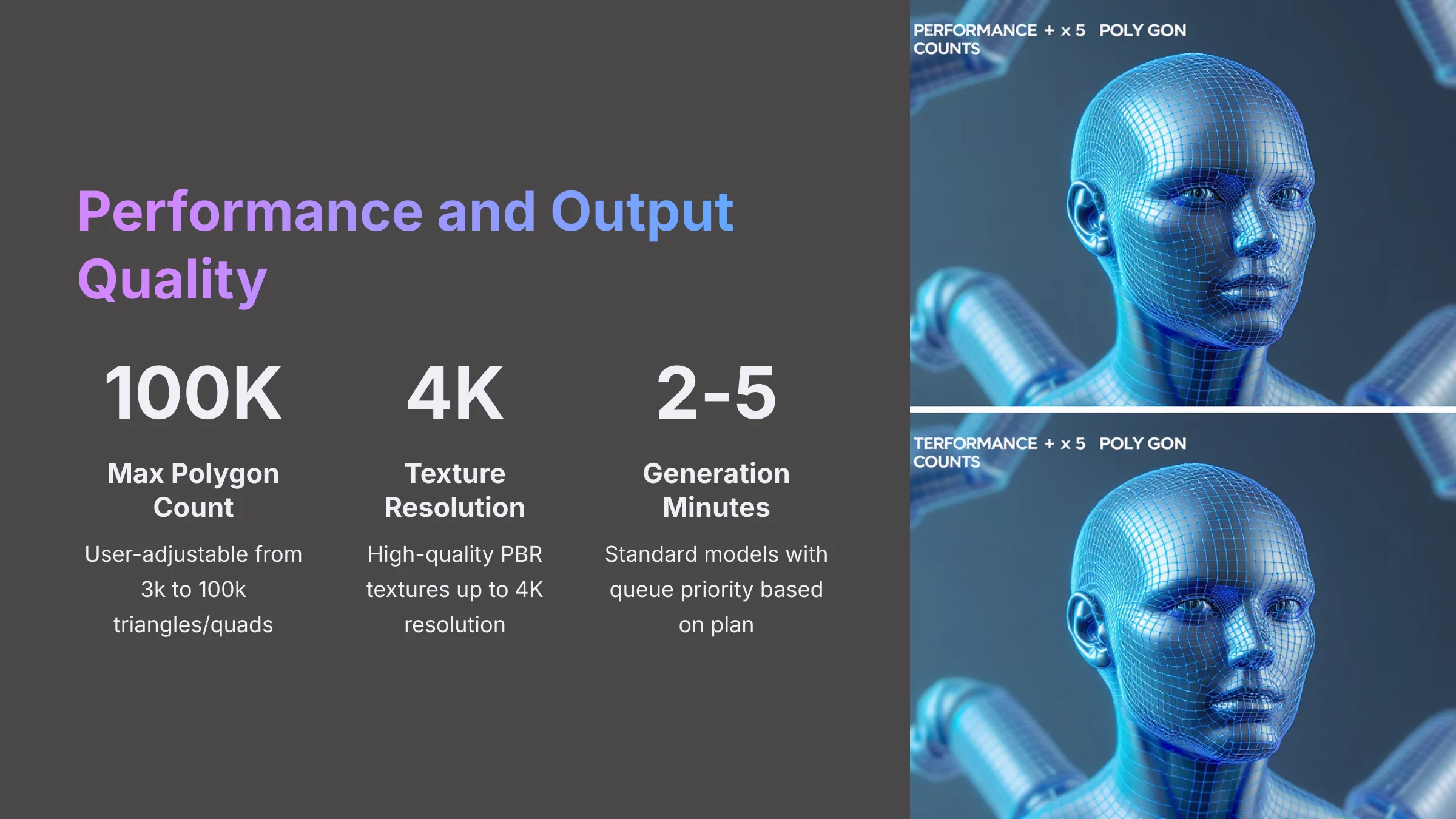

This table details the quality and speed you can expect from Meshy. A key factor to note is queue priority. Free plan users may see longer wait times during busy hours, while Max and Enterprise users have their jobs processed first.
| Metric | Specification |
|---|---|
| Polygon Count | User-adjustable: 3k, 10k, 30k, 100k (triangles/quads) |
| Texture Resolution | Up to 4K |
| Generation Speed | ~2-5 minutes for standard models. Queue priority depends on plan. |
| Rigging | Automatic for bipedal and quadruped models. |
Practical Use Cases and Applications
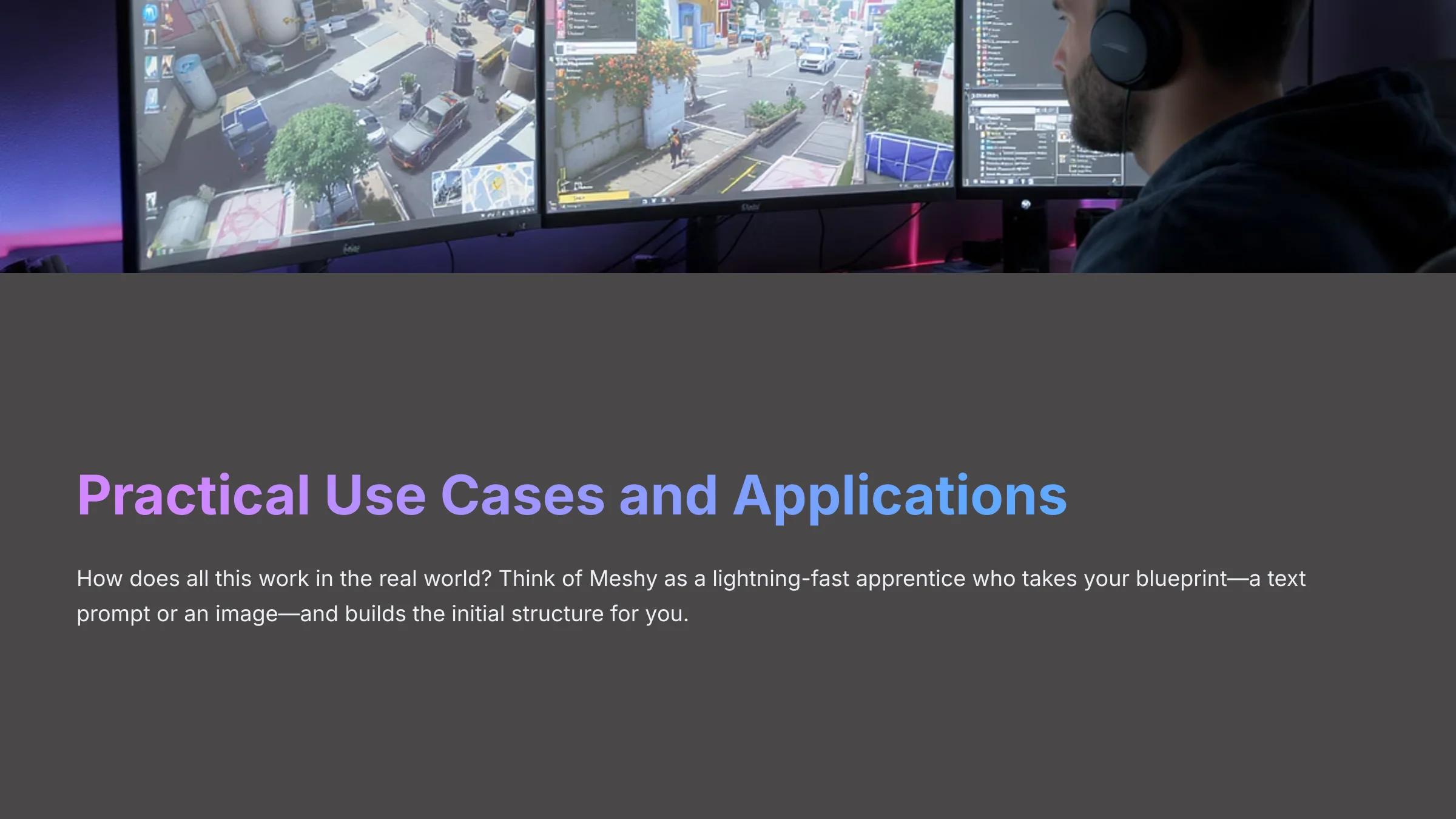

So, how does all this work in the real world? Here are a few practical examples that show how Meshy can fit directly into your workflow. For instance, think of Meshy as a lightning-fast apprentice who takes your blueprint—a text prompt or an image—and builds the initial structure for you.
Rapid Prototyping for Game Development
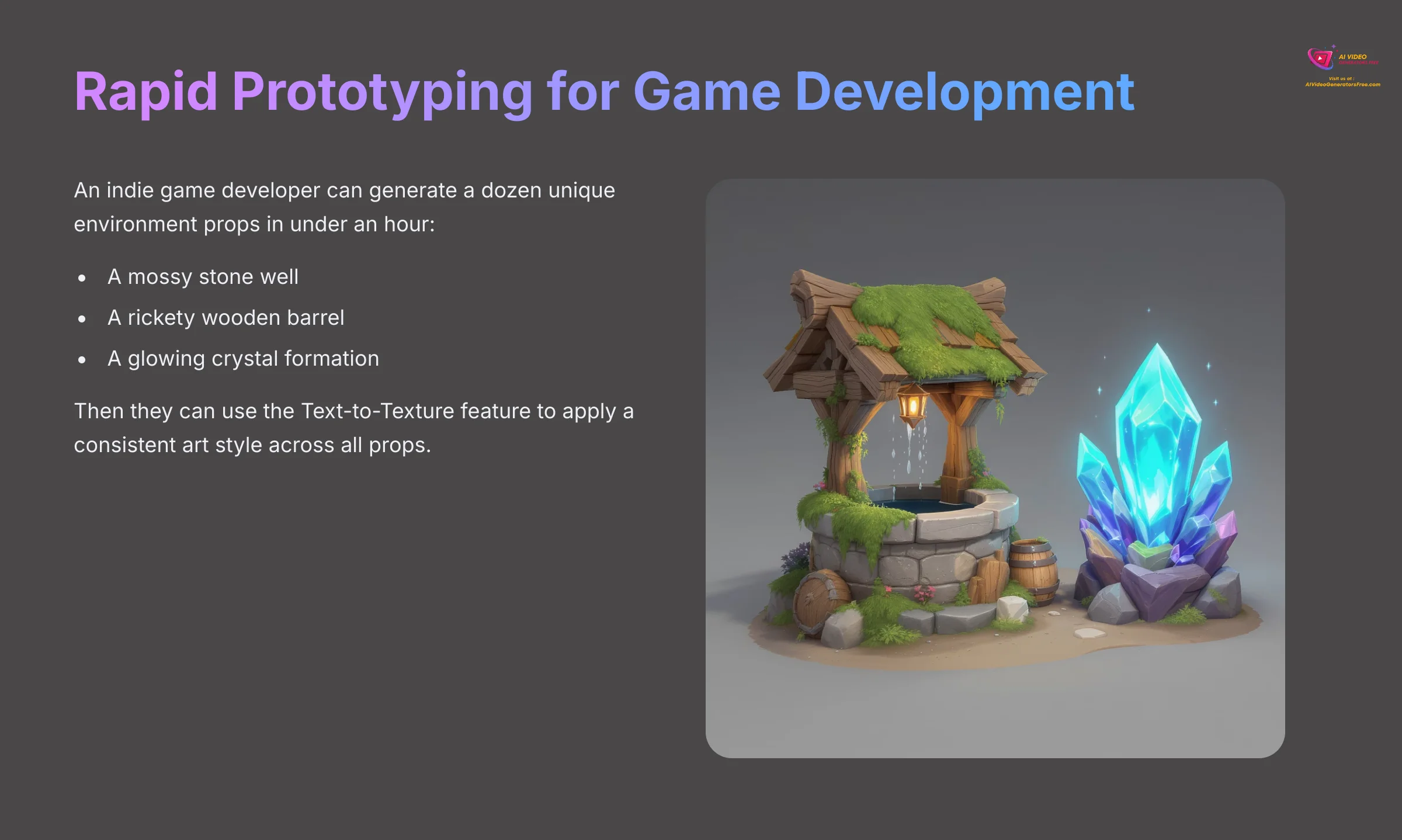

An indie game developer can generate a dozen unique environment props in under an hour. For example, they can create ‘a mossy stone well,' ‘a rickety wooden barrel,' and ‘a glowing crystal formation.' Then they can use the Text-to-Texture feature to apply a consistent art style across all of them.
Concept Visualization for 3D Artists and Designers
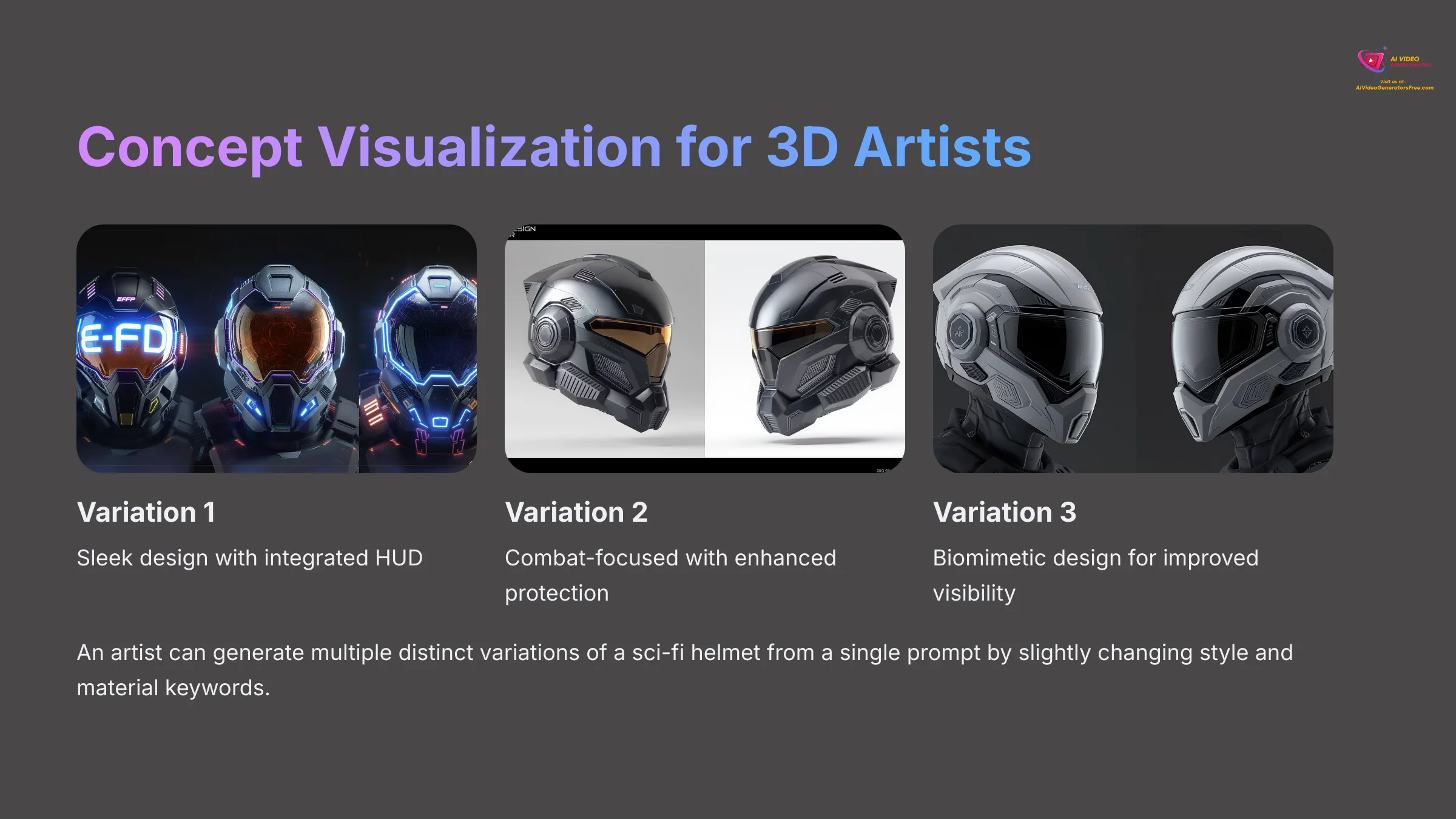

An artist can generate five distinct variations of a sci-fi helmet from a single prompt. They just need to slightly change style and material keywords. This allows for quick concept exploration before committing to a final design in a program like Blender or ZBrush.
Immersive Asset Creation for AR and VR (XR)
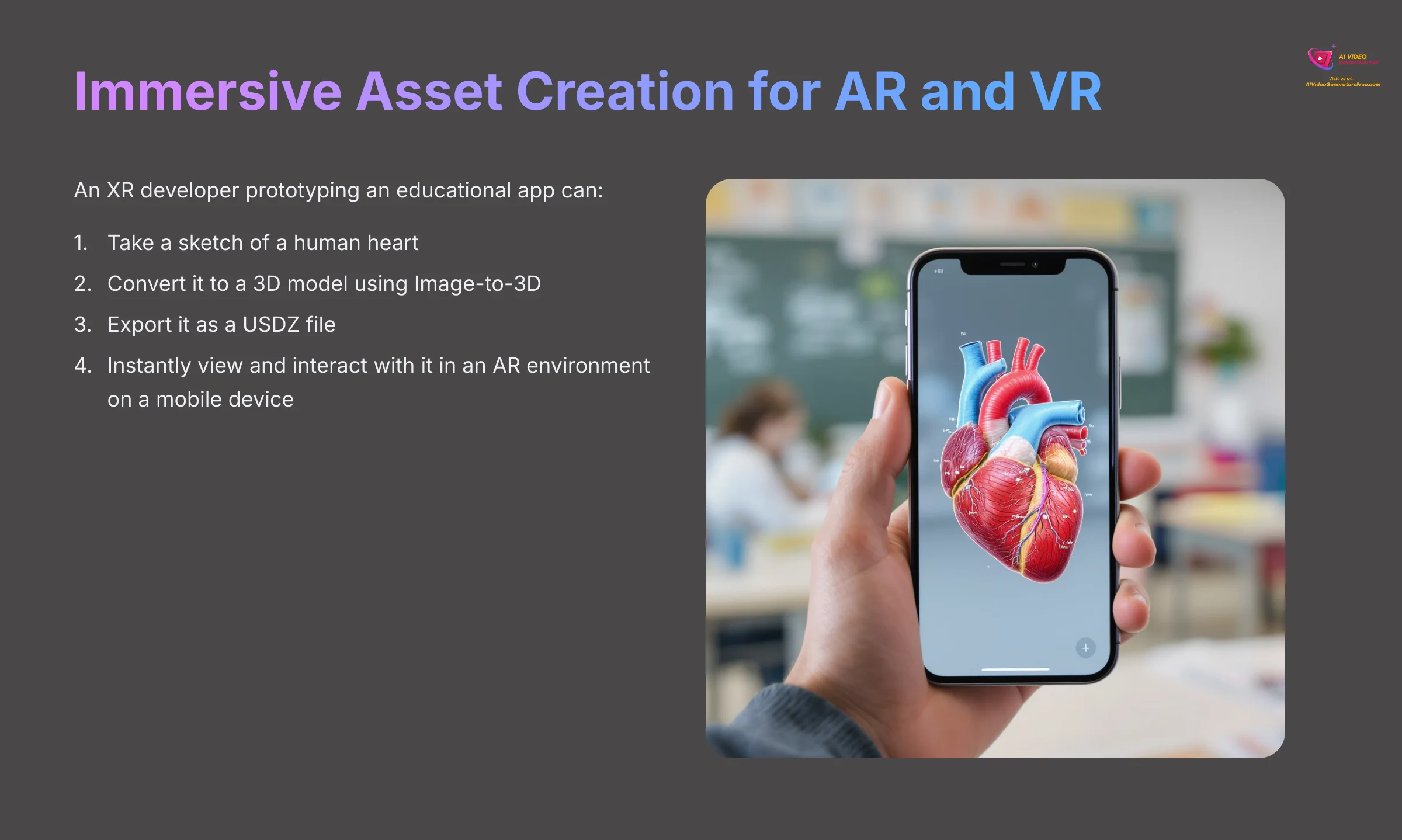

An XR developer prototyping an educational app can take a sketch of a human heart. They can convert it to a 3D model using Image-to-3D. Then, they can export it as a USDZ file to instantly view and interact with it in an AR environment on a mobile device.
Meshy vs. The Competition: How it Stacks Up in 2025
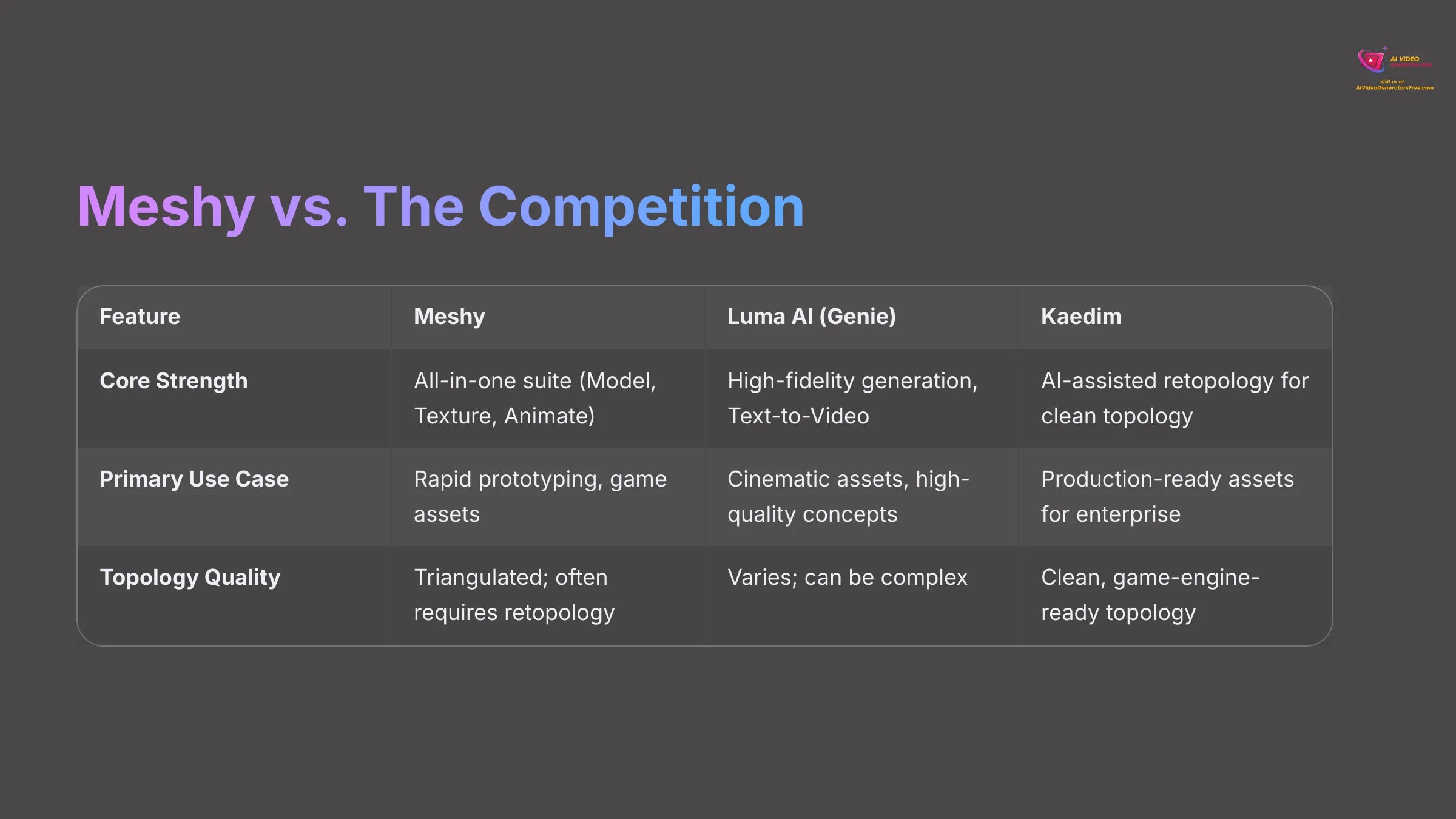

No tool exists in isolation. To provide a complete overview, it's essential to see how Meshy compares to other major players in the generative 3D space. My team's analysis shows Meshy's strength lies in its all-in-one workflow, while competitors may specialize in different areas.
| Feature / Competitor | Meshy | Luma AI (Genie) | Kaedim |
|---|---|---|---|
| Core Strength | All-in-one suite (Model, Texture, Animate) | High-fidelity generation, Text-to-Video | AI-assisted retopology for clean, quad-based topology |
| Primary Use Case | Rapid prototyping, game assets | Cinematic assets, high-quality concepts | Production-ready assets for enterprise and studios |
| Topology Quality | Triangulated; often requires retopology | Varies; can be complex | Focus on clean, game-engine-ready topology |
| Texturing | Integrated AI Text-to-Texture (PBR) | Integrated texturing | PBR texturing with human quality assurance options |
| Integration | Unity and plugins in development | Web-based, API access | Plugins for all major DCCs (Blender, Maya, etc.) |
Verdict: Choose Meshy for speed and its comprehensive toolkit for indie projects. Look to Luma AI for cutting-edge visual fidelity and video features. Opt for Kaedim when clean, production-quality topology is non-negotiable from the start.
Limitations and Technical Considerations
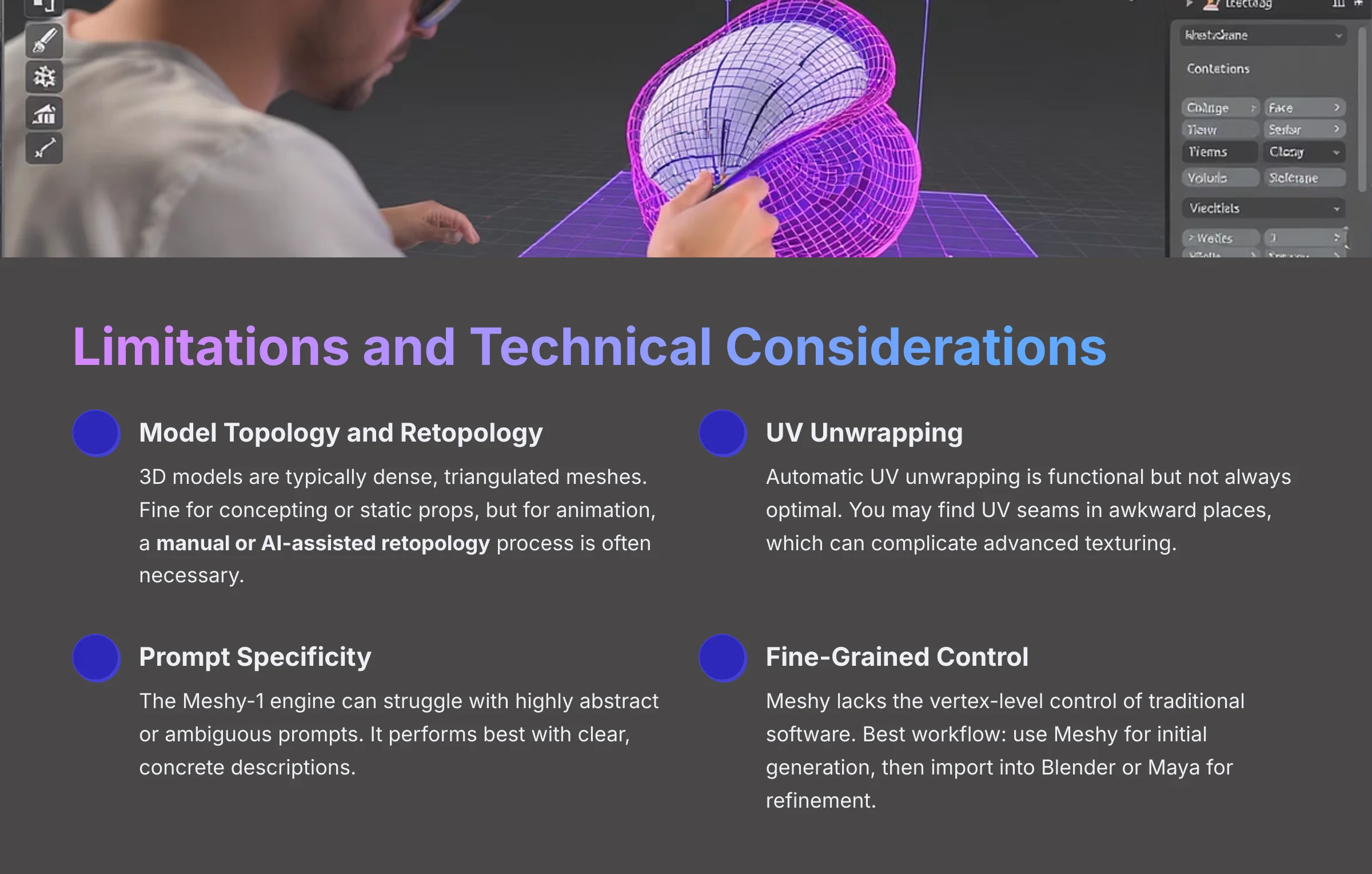

While Meshy is a powerful accelerator, it's crucial to understand its limitations to use it effectively. This is not a “one-click-to-final-asset” solution for high-end productions without some manual cleanup.
- Model Topology and Retopology: The 3D models generated by Meshy, especially at high polygon counts, are typically composed of dense, triangulated meshes. This is fine for concepting or static props, but for animation or further sculpting, a manual or AI-assisted retopology process in a tool like Blender is often necessary to create a clean, quad-dominant mesh.
- UV Unwrapping: The automatic UV unwrapping is functional but not always optimal. You may find UV seams in awkward places, which can complicate advanced texturing. For hero assets, you will likely need to re-unwrap the model manually.
- Prompt Specificity: The Meshy-1 engine is impressive, but it can struggle with highly abstract or ambiguous prompts. It performs best with clear, concrete descriptions. Expect to iterate on your prompts to refine the output.
- Fine-Grained Control: Meshy is a co-creator, not a replacement for a skilled artist. It lacks the fine-grained vertex-level control of traditional Digital Content Creation (DCC) software like Blender or Maya. The best workflow involves using Meshy for initial generation and then importing the asset into your preferred software for final refinement.
Meshy Pricing and Plans (2025)


After seeing what Meshy can do, the next logical question is about cost. The platform offers several tiers to fit different needs and budgets. It is important to note the license distinction. On the Free plan, all your creations are public and licensed under CC BY 4.0. You should not use this for any proprietary or client-sensitive projects.
For a small studio or serious freelancer, my experience shows the Pro plan offers the best value. The private and owned asset licensing is non-negotiable for commercial work. If you're just starting or exploring for fun, the Free plan is perfectly functional, but for any client project, you must start with the Pro plan.
| Feature | Free Plan | Pro Plan | Max Plan | Max Unlimited |
|---|---|---|---|---|
| Price/Month | $0 | $20 ($16/yr) | $60 ($48/yr) | $120 ($96/yr) |
| Monthly Credits | 200 | 1,000 | 4,000 | 4,000 + Unlimited Relaxed |
| Queue Priority | Limited | Standard | Maximized | Maximized |
| Asset License | CC BY 4.0 (Public) | Private & Owned | Private & Owned | Private & Owned |
| API Access | Yes | Yes | Yes | Yes |
| AI Texturing | No | Yes | Yes | Yes |
| Animation | No | Yes | Yes | Yes |
| Image-to-3D Retries | 0 | 4 | 8 | Unlimited |
Disclaimer: The information about Meshy Overview presented in this article reflects our thorough analysis as of 2025. Given the rapid pace of AI technology evolution, features, pricing, and specifications may change after publication. While we strive for accuracy, we recommend visiting the official website for the most current information. Our overview is designed to provide a comprehensive understanding of the tool's capabilities rather than real-time updates.
Is Meshy the Right 3D Generation Tool for You?
So, what's the final verdict? Is Meshy the right tool for you? My answer is a clear yes, especially if you are a developer or designer looking to drastically cut down on initial modeling and texturing time. For prototyping and creating game-ready assets in 2025, it's a top contender. Additionally, the intuitive interface and robust features make it accessible for both beginners and seasoned professionals alike. In this Meshy Review, you’ll find insights into its performance and unique functionalities that set it apart from other tools in the market. Ultimately, investing in Meshy could be a game-changer for your creative workflow.
It might not replace the fine-tuned control of traditional software for final, high-detail assets. But its ability to rapidly generate high-quality, fully-textured models is a major advantage. It allows you to focus your energy on creativity and refinement instead of tedious groundwork. Based on my comprehensive Meshy Overview testing, it's a powerful addition to any 3D artist's toolkit.
Frequently Asked Questions (FAQs)
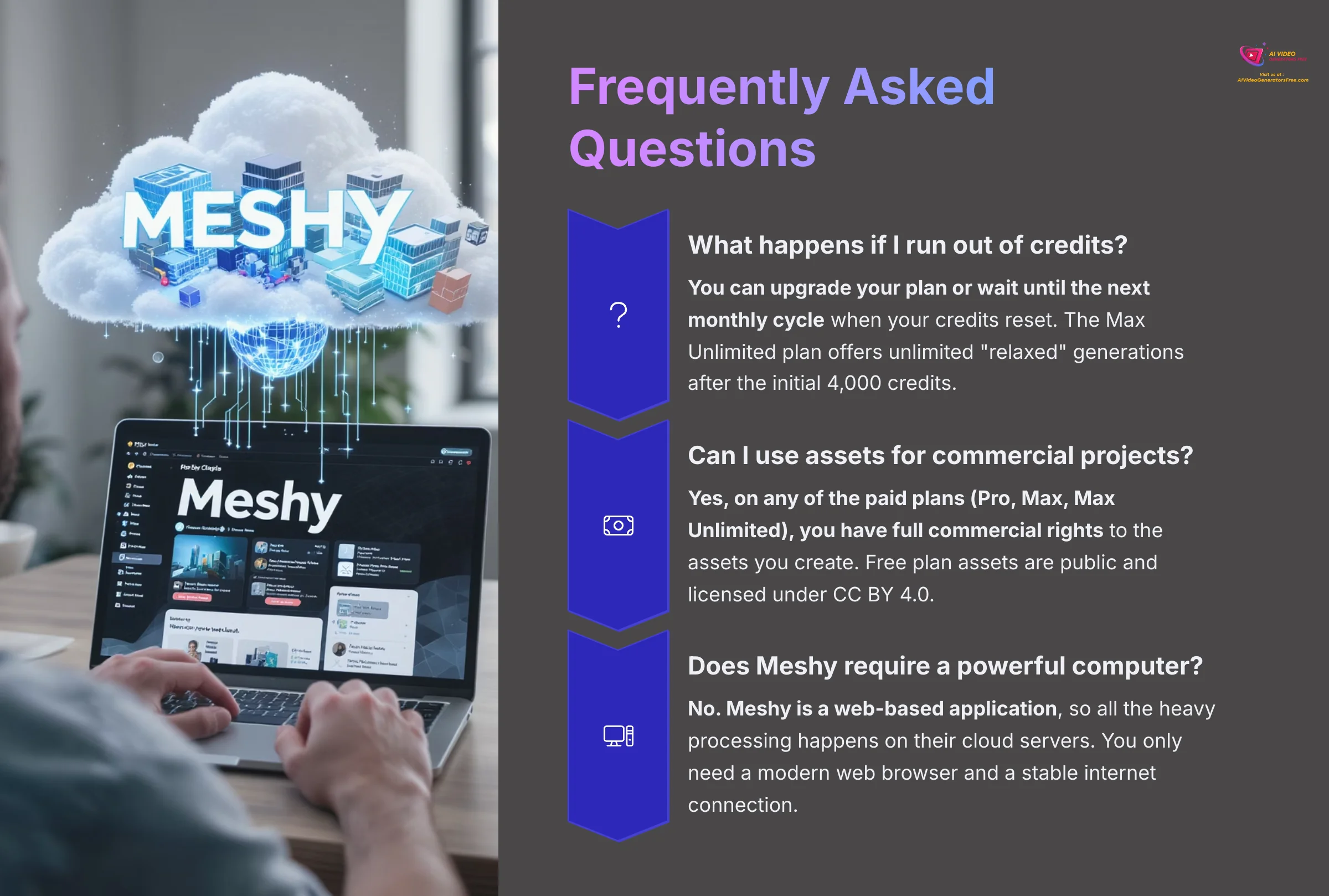

- Q1: What happens if I run out of credits?
- A: You can upgrade your plan or wait until the next monthly cycle when your credits reset. The Max Unlimited plan offers unlimited “relaxed” generations after the initial 4,000 credits are used.
- Q2: Can I use assets created with Meshy for commercial projects?
- A: Yes, on any of the paid plans (Pro, Max, Max Unlimited), you have full commercial rights to the assets you create. Assets created on the Free plan are public and licensed under CC BY 4.0.
- Q3: Does Meshy require a powerful computer to run?
- A: No. Meshy is a web-based application, so all the heavy processing happens on their cloud servers. You only need a modern web browser and a stable internet connection.
- Q4: How does the “relaxed” generation on the Unlimited plan work?
- A: “Relaxed” generations do not use your priority credits and are placed in a lower-priority queue. This means they may take longer to process, but they are unlimited.
- Q5: What is the quality of the 3D model's topology and UVs?
- A: Meshy generates a dense, sculpted mesh that is visually detailed but often requires cleanup for professional use. The topology is typically triangulated and not optimized for animation out-of-the-box. This means a retopology workflow in a program like Blender is recommended for character models or hero assets. Similarly, the automatic UVs are a great starting point but may need manual refinement to hide seams for perfect texturing.
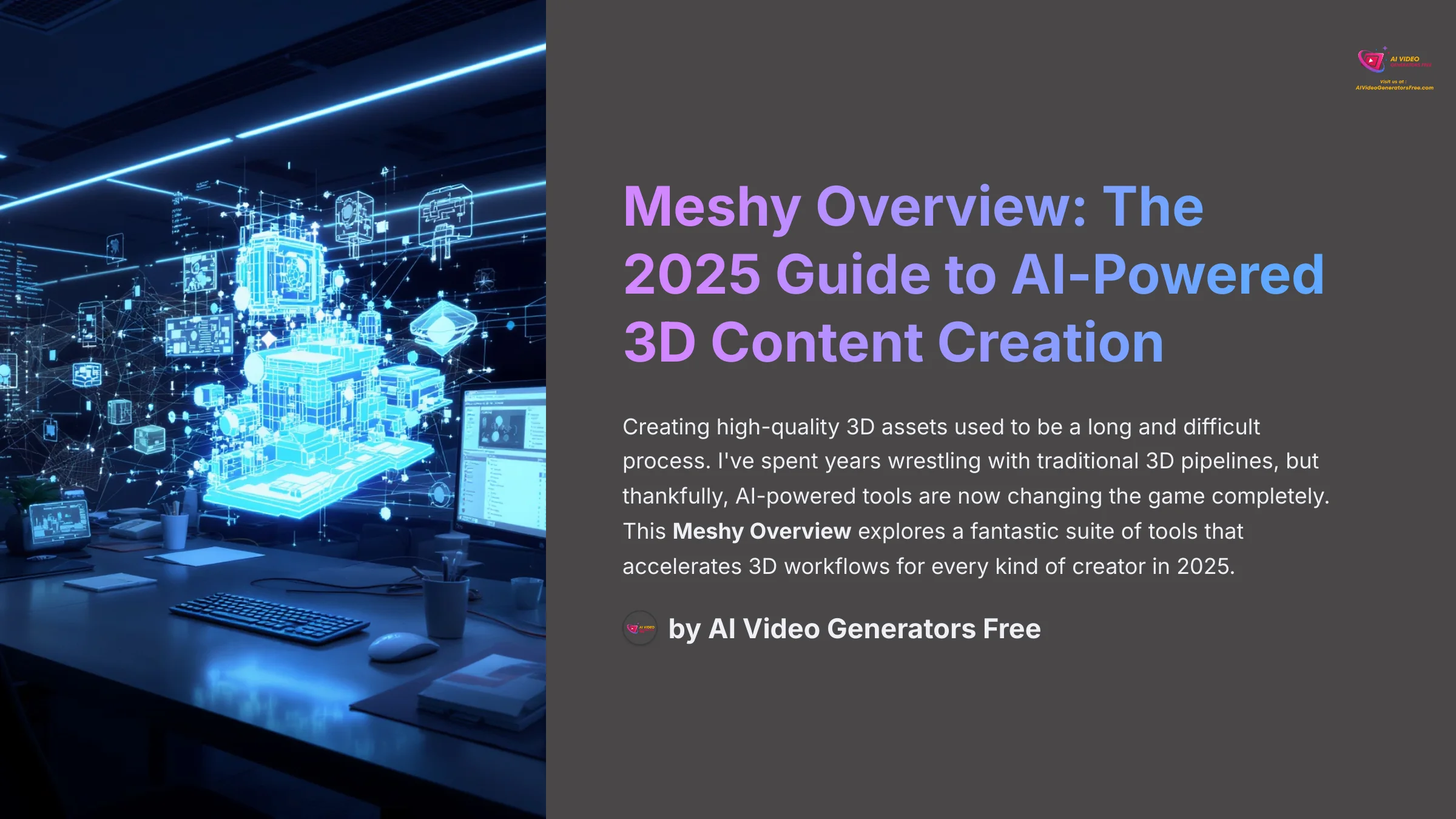
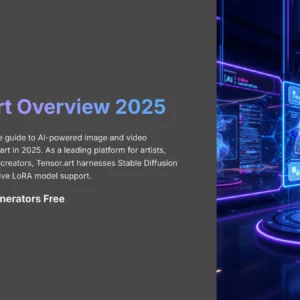
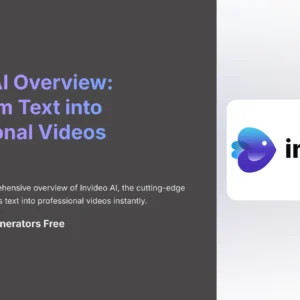
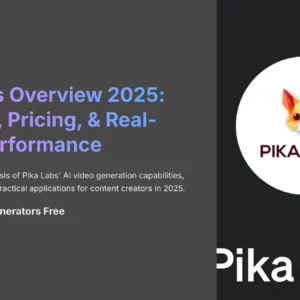
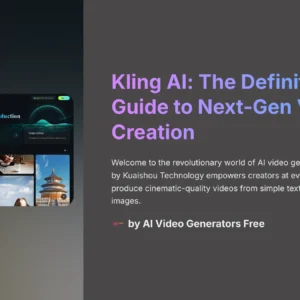



Reviews
There are no reviews yet.